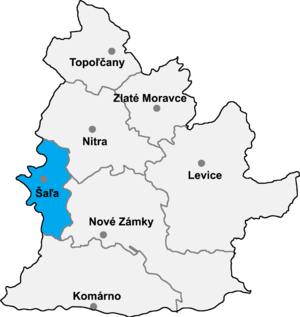
Selice
Encyclopedia

Village
A village is a clustered human settlement or community, larger than a hamlet with the population ranging from a few hundred to a few thousand , Though often located in rural areas, the term urban village is also applied to certain urban neighbourhoods, such as the West Village in Manhattan, New...
and municipality
Municipality
A municipality is essentially an urban administrative division having corporate status and usually powers of self-government. It can also be used to mean the governing body of a municipality. A municipality is a general-purpose administrative subdivision, as opposed to a special-purpose district...
in Šaľa District
Šala District
Šaľa District is a district in the Nitra Region of western Slovakia.Until 1918, the district formed mostly part of the Hungarian county of Nitra, apart from a small area in the west around Diakovce, Tešedíkovo and Žihárec which formed part of the county of Pressburg.- Municipalities...
, in the Nitra Region
Nitra Region
The Nitra Region is one of the administrative regions of Slovakia.-Geography:This region with a long history is situated in the southwest of Slovakia, mostly in the eastern part of the Danubian Lowland. It is divided into two sub-units: the Danubian Flat in the south-west, with eastern part of the...
of south-west Slovakia
Slovakia
The Slovak Republic is a landlocked state in Central Europe. It has a population of over five million and an area of about . Slovakia is bordered by the Czech Republic and Austria to the west, Poland to the north, Ukraine to the east and Hungary to the south...
.
History
In historical recordsHistory
History is the discovery, collection, organization, and presentation of information about past events. History can also mean the period of time after writing was invented. Scholars who write about history are called historians...
the village was first mentioned in 1078. In the 16th century, it was destroyed by Ottoman Turks. In 1938-1945 it was part of Hungary. In 1946, the separate (and larger) village of Šók (Slovak; Sók or Magyarsók in Hungarian, Šóka in Romani) became part of Selice.
Geography
The villageVillage
A village is a clustered human settlement or community, larger than a hamlet with the population ranging from a few hundred to a few thousand , Though often located in rural areas, the term urban village is also applied to certain urban neighbourhoods, such as the West Village in Manhattan, New...
lies at an altitude
Altitude
Altitude or height is defined based on the context in which it is used . As a general definition, altitude is a distance measurement, usually in the vertical or "up" direction, between a reference datum and a point or object. The reference datum also often varies according to the context...
of 113 metres and covers an area
Area
Area is a quantity that expresses the extent of a two-dimensional surface or shape in the plane. Area can be understood as the amount of material with a given thickness that would be necessary to fashion a model of the shape, or the amount of paint necessary to cover the surface with a single coat...
of 38.36 km².
It has a population
Population
A population is all the organisms that both belong to the same group or species and live in the same geographical area. The area that is used to define a sexual population is such that inter-breeding is possible between any pair within the area and more probable than cross-breeding with individuals...
of about 2915 people.
Ethnicity
In a 2001 census, 59% (1682) of the inhabitants claimed Hungarian ethnicity, 36% (1011) SlovakSlovaks
The Slovaks, Slovak people, or Slovakians are a West Slavic people that primarily inhabit Slovakia and speak the Slovak language, which is closely related to the Czech language.Most Slovaks today live within the borders of the independent Slovakia...
ethnicity and 4% (108) Romani (Gypsy) ethnicity. In a 1991 census, the numbers were 75% (2079), 21% (565) and 3% (83), respectively. The main reason behind the apparent decrease in the number of ethnic Hungarians is the fact that most Roma, who in fact represented 52% (1479) of the village population in 2005, claimed Slovak or Hungarian ethnicity. According to a 1968 census, there were 787 ‘citizens of Gypsy origin’ in Selice.
External links
- http://www.statistics.sk/mosmis/eng/run.html
- Selice Romani Vocabulary List (from the World Loanword Database)

